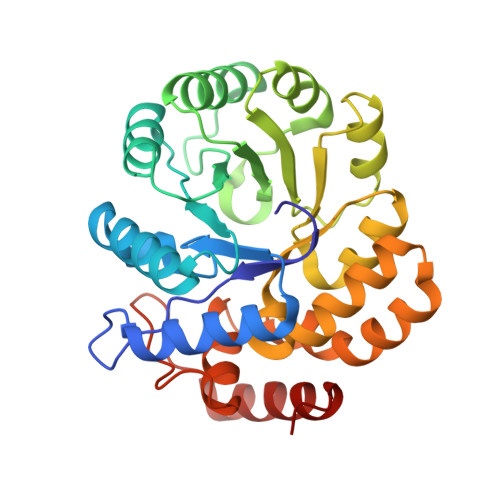How essential is the 'essential' active-site lysine in dihydrodipicolinate synthase?
Soares da Costa, T.P., Muscroft-Taylor, A.C., Dobson, R.C., Devenish, S.R., Jameson, G.B., Gerrard, J.A.(2010) Biochimie 92: 837-845
- PubMed: 20353808
- DOI: https://doi.org/10.1016/j.biochi.2010.03.004
- Primary Citation of Related Structures:
3I7Q, 3I7R, 3I7S - PubMed Abstract:
Dihydrodipicolinate synthase (DHDPS, E.C. 4.2.1.52), a validated antibiotic target, catalyses the first committed step in the lysine biosynthetic pathway: the condensation reaction between (S)-aspartate beta-semialdehyde [(S)-ASA] and pyruvate via the formation of a Schiff base intermediate between pyruvate and the absolutely conserved active-site lysine. Escherichia coli DHDPS mutants K161A and K161R of the active-site lysine were characterised for the first time. Unexpectedly, the mutant enzymes were still catalytically active, albeit with a significant decrease in activity. The k(cat) values for DHDPS-K161A and DHDPS-K161R were 0.06 +/- 0.02 s(-1) and 0.16 +/- 0.06 s(-1) respectively, compared to 45 +/- 3 s(-1) for the wild-type enzyme. Remarkably, the K(M) values for pyruvate increased by only 3-fold for DHDPS-K161A and DHDPS-K161R (0.45 +/- 0.04 mM and 0.57 +/- 0.06 mM, compared to 0.15 +/- 0.01 mM for the wild-type DHDPS), while the K(M) values for (S)-ASA remained the same for DHDPS-K161R (0.12 +/- 0.01 mM) and increased by only 2-fold for DHDPS-K161A (0.23 +/- 0.02 mM) and the K(i) for lysine was unchanged. The X-ray crystal structures of DHDPS-K161A and DHDPS-K161R were solved at resolutions of 2.0 and 2.1 A respectively and showed no changes in their secondary or tertiary structures when compared to the wild-type structure. The crystal structure of DHDPS-K161A with pyruvate bound at the active site was solved at a resolution of 2.3 A and revealed a defined binding pocket for pyruvate that is thus not dependent upon lysine 161. Taken together with ITC and NMR data, it is concluded that although lysine 161 is important in the wild-type DHDPS-catalysed reaction, it is not absolutely essential for catalysis.
Organizational Affiliation:
Biomolecular Interaction Centre and School of Biological Sciences, University of Canterbury, Christchurch, New Zealand.

















